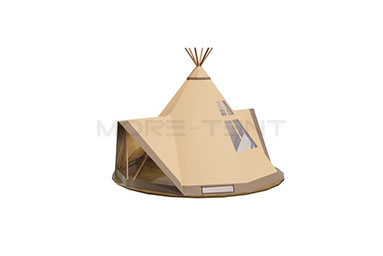In the hot summer, as a semi-permanent outdoor architecture, how to effectively keep the glamping tent cool and ventilated is the key. By carefully selecting materials, optimizing structural design, configuring auxiliary facilities and regular maintenance, the heat dissipation performance of the tent can be greatly improved, providing tourists with a comfortable living experience.

Tent material selection
Choosing high-quality PVC-coated polyester textile as the cover material is the basis for keeping the tent cool. This material is not only windproof, waterproof, sun-proof, flame-retardant and snow-resistant, but also has good thermal insulation properties, which helps the tent block the heat outside the tent. In the hot summer, it can achieve a rapid cooling effect when used with air conditioning equipment.

Tent structure design
A properly designed tent ventilation system is the key to keeping cool in summer.
Top vents and skylights: Setting up top vents or skylights can use natural wind to discharge hot air and help internal air circulation.
Door and window layout: When designing, reasonably arrange the positions of doors and windows to ensure smooth air circulation and reduce the feeling of stuffiness.
Double-layer roof and sunshade facilities: Use a double-layer roof structure, or install an awning or sunshade net on the outside of the tent to effectively block direct sunlight and reduce the temperature inside the tent.

Auxiliary facilities: Improve heat dissipation efficiency
With the help of modern auxiliary facilities, the thermal environment inside the tent can be significantly improved
Air conditioning equipment: Air conditioning is the best tool for rapid cooling, providing visitors with a cool resting space.
Fans and exhaust fans: Fans and exhaust fans can enhance air flow and promote internal air circulation, further improving cooling.

Daily maintenance: ensure the system runs efficiently
Regular maintenance is important to keep your tent cool.
Cleaning: Clean the cover and internal facilities regularly to avoid dust and dirt accumulation that affects the heat dissipation effect.
Vent inspection: Check whether the vents, doors and windows are unobstructed to ensure that the cooling system is functioning properly.
Through the comprehensive application of the above strategies, the heat dissipation performance of the glamping tent will be significantly improved in summer, creating a cool and comfortable outdoor accommodation environment for tourists, allowing people to get closer to nature more comfortably.




